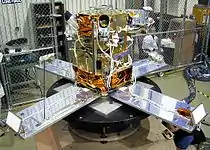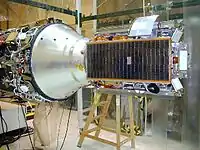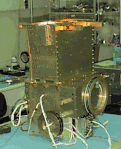High Energy Transient Explorer
The High Energy Transient Explorer (abbreviated HETE; also known as Explorer 79) was an American astronomical satellite with international participation (mainly Japan and France). The prime objective of HETE was to carry out the first multiwavelength study of gamma-ray bursts with UV, X-ray, and gamma-ray instruments mounted on a single, compact spacecraft. A unique feature of the HETE mission was its capability to localize GRBs with ~10 arc second accuracy in near real time aboard the spacecraft, and to transmit these positions directly to a network of receivers at existing ground-based observatories enabling rapid, sensitive follow-up studies in the radio, IR, and optical bands. The satellite bus for the first HETE-1 was designed and built by AeroAstro, Inc. of Herndon, VA; the replacement satellite, HETE-2, was built by MIT based on the original HETE design.
| Names | HETE-1 |
|---|---|
| Mission type | High-energy astronomy |
| Operator | NASA |
| COSPAR ID | 1996-061A |
| SATCAT no. | 24645a |
| Spacecraft properties | |
| Manufacturer | AeroAstro, Inc |
| Launch mass | 128 kilograms (282 lb) |
| End of mission | |
| Disposal | Launch failure |
| Destroyed | November 4, 1996 |
| Decay date | April 7, 2002 |
| Orbital parameters | |
| Reference system | Geocentric |
| Eccentricity | 0.0 |
| Perigee altitude | 487 kilometres (303 mi) |
| Apogee altitude | 555 kilometres (345 mi) |
| Inclination | 38.0° |
| Epoch | November 4, 1996 |
 HETE 2 | |
| Mission type | Astronomy |
|---|---|
| Operator | NASA |
| COSPAR ID | 2000-061A |
| SATCAT no. | 26561 |
| Mission duration | October 2000 - March 2008 |
| Spacecraft properties | |
| Bus | HETE |
| Manufacturer | Massachusetts Institute of Technology |
| Launch mass | 124 kilograms (273 lb) |
| Power | 4 deployable fixed solar arrays |
| Start of mission | |
| Launch date | October 9, 2000, 05:38:00 UTC |
| Rocket | Pegasus-H |
| Launch site | Kwajalein |
| End of mission | |
| Disposal | Deactivated |
| Deactivated | March 2008 |
| Orbital parameters | |
| Reference system | Geocentric |
| Regime | LEO |
| Semi-major axis | 6,932 kilometers (4,307 mi) |
| Eccentricity | 0.0018587 |
| Perigee altitude | 534 kilometers (332 mi) |
| Apogee altitude | 559 kilometers (347 mi) |
| Inclination | 1.9485° |
| Period | 95.7 minutes |
| RAAN | 207.197 degrees |
| Argument of perigee | 13.7551 degrees |
| Mean anomaly | 346.2996 degrees |
| Mean motion | 85387 |
| Epoch | May 9, 2016 at 15:49:27 UTC |
Launch attempts
The first HETE was lost during the launch on November 4, 1996. The Pegasus rocket achieved a good orbit, but explosive bolts releasing HETE from another satellite (Argentina's SAC-B) and from its DPAF (Dual Payload Attach Fitting) envelope failed to charge, dooming both satellites. A battery on the third stage of the rocket and responsible for these bolts cracked during the ascent.

A second HETE satellite, HETE-2, was launched on October 9, 2000 in a follow-up mission. It was similar to the first HETE, but replaced the UV camera with an additional X-ray camera (Soft X-ray Camera or SXC) capable of higher localization accuracy than the original X-ray instrument (Wide-Field X-ray Monitor or WXM).
HETE-2 was placed in a 625 km altitude Earth orbit with an inclination of 0-2 degrees.[1]
Originally planned operational life was 18 months.[2] The mission continued until March 2008.[3]
Achievements
Among the achievements of the HETE-2 mission are:
- The discovery of GRB 030329, a widely observed, nearby gamma ray burst, firmly connecting GRBs with supernovas.
- The discovery of GRB 050709, which was the first short/hard GRB to be found with an optical counterpart, leading to a firm establishment of the cosmological origin of this subclass of GRBs.
- Dark bursts, or GRBs previously thought to have no optical counterparts, are not completely optically dark. Some of these dark GRBs fade in the optical very rapidly, others are dimmer but detectable with large (meter class) telescopes.
- The establishment of another subclass of GRBs, the less energetic X-Ray Flashes (XRF), and its first optical counterpart.
- The first to send out arcminute positions of GRBs to the observation community within tens of seconds of the onset of GRB (and in a few instances, while the burst was ongoing).
Burst alert summary
The HETE website lists 6 GRBs in 2001, 19 in 2002, 25 in 2003, 19 in 2004, 12 in 2005, and 3 in 2006 - the last reported being in March 2006.[4]
The trigger summaries list 2 GRBs in May 2006 and an XRB in Jan 2007.[5]
Latest status
As of March 2007, "the operational efficiency of the HETE spacecraft and instruments has decreased due to the advanced age of the NiCd batteries on board."[6]
The mission ended in March 2008.[3]
Gallery
 HETE under test
HETE under test HETE-2 attached to its Pegasus launcher
HETE-2 attached to its Pegasus launcher Implementation of the launcher fairing
Implementation of the launcher fairing FREGATE instrument
FREGATE instrument WXM instrument
WXM instrument
References
- "HETE-2 Spacecraft". MIT School of Science. Retrieved February 18, 2019.
- "HETE 1, 2". Gunter's Space Page. Retrieved February 18, 2019.
- "The HETE-2 Satellite". Goddard Space Flight Center. January 29, 2014. Retrieved February 18, 2019.
- "HETE Bursts". MIT School of Science. Retrieved February 18, 2019.
- "HETE Trigger Summaries: H40xx". MIT School of Science. January 6, 2009. Retrieved February 18, 2019.
- "HETE Mission Status". MIT School of Science. March 28, 2007. Retrieved February 18, 2019.
External links
- HETE-2 at MIT
.png.webp)